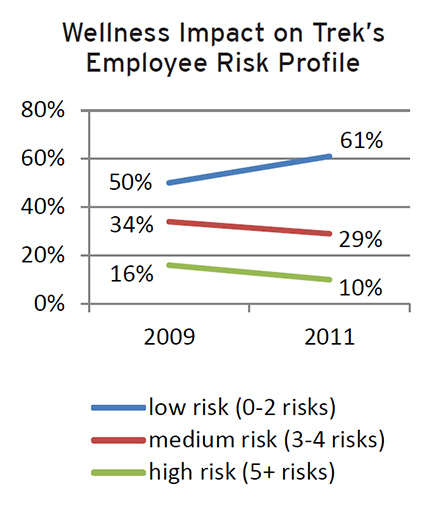Trek Bicycle Corporation’s willingness to encourage personal accountability in promoting employee health has resulted in significant progress toward its wellness goal: keeping people happy, healthy, and alive.
Trek measures its success through wellness program participation that has consistently topped 99% among employees covered by its health plan since 2008; a significant reduction in employee health risk; and employees’ willingness to use wellness programs to transform their lives.
A Shift in Approach
As a leading manufacturer of bikes for competition and recreation, wellness has always been part of Trek’s philosophy, according to Jennifer Pagels, director of human resources. Based in Waterloo, Wis., Trek initially focused on wellness as a way to keep employees happy and healthy. Health risk assessments (HRAs) were introduced on-site in 2005 as a voluntary measure, drawing 21 percent of employees. The next year, Trek used a $100 cash incentive to boost participation to 61 percent.
But things changed in 2007 when a 20-year employee died suddenly, and the spouse of another long-term employee suffered a debilitating stroke.
“Those really bad situations made us say that we’re not going to sit back and continue to give people cash or a T-shirt for doing an HRA,” Pagels says. “We’re going to hold people accountable for their health and lifestyle decisions.”
CEO John Burke introduced a formal wellness program to all employees, not to save money, but to save lives. It would hold both the company and employees accountable for making changes required to improve their health.
A Public Employer
The company linked payment of the employer’s contribution to the 2009 health insurance premium, valued at an average of $269 biweekly, to full participation in HRAs for the employee and spouse, biometric screening, coaching and a nutrition class.
“We became very heavy-handed and had a big stick,” Pagels says. “But the reason for the stick was directly connected to the historic things that happened. Very quickly we got to 99 percent participation.”
Trek now asks employees to qualify for the health premium by HRA and biometric screening participation as well as earning 1000 “wellness points” by participation in preventive exams, health screenings, health coaching or fitness activities and programs. More than 99 percent of the 780 employees enrolled in the health plan completed an HRA in 2010. Even employees who do not participate in Trek’s health benefits program are asked to complete an HRA, with 75 percent participation among all Trek’s 1200 U.S. employees.

Results have been impressive, with decreases in health risks, treatment costs for major disease states and absences.
Trek Wellness Components:
- HRAs
- Health coaching
- On-site nutrition seminars
- Onsite café and vending machines with healthy choices
- Unhealthy food choices cost more with “Twinkie Tax”
- “Health Value” pricing lowers price of healthy choices to below-market cost
- Bike to work incentives
- On-site fitness center with daily classes
- Mountain bike trails
- Go By Bike League sets and achieves team goals for using a bike instead of a car
- Biggest Loser Challenge
- “Lavatory Learning” shares wellness messages in bathrooms, where they are difficult to miss
Steps to Wellness
Trek’s diverse approach reflects the Wellness Council of America (WELCOA) Well Workplace model benchmarks for success.
“These are the key pillars to what has helped make our program successful,” Pagels says.
Hiring a wellness program coordinator was an essential early commitment, Pagels says, because the coordinator helped Trek allocate its resources and decide which battles were worth fighting, such as subsidizing healthy eating choices in the cafeteria.
Many steps on the WELCOA list were adapted to meet Trek’s needs. For example, Trek observes which wellness options resonate with employees and what barriers prevent participation, rather than conducting a formal survey. Instead of a wellness library, Trek uses online sites and materials.
“We focus on making it easy for people,” Pagels says.
Those efforts have paid off by decreasing the number of health claims filed each year. The average health score continues to increase, moving from 786 of a possible 1,000 points in 2010 to an average 849 points in 2011. Pagels notes that Trek has a relatively healthy workforce yet still struggles in some areas, such as body fat percentage.
The Biggest Loser Trek’s latest wellness success is adapting the “Biggest Loser” television show’s approach. Employees pay $150 to enroll in the 12-week program led by a fitness trainer and nutritionist, who challenge competing teams of five to eight people to set and reach their goals. The fee can be paid in three installments by payroll deduction and is fully refunded if participants meet their goals.
Teams make a commitment to fitness with daily classes and meetings that combine cardio and weight training with review of food journals and nutrition education. Pre- and post-assessment sessions measure improvements in weight, body measurements and fitness. The top male and female participants and top team are recognized.
One year after program launch, Trek’s 208 “Biggest Loser” participants had lost 773 pounds, reduced body fat from 29 to 27 percent and reduced their total cholesterol ratio from 4.1 to 3.6. And, their average health score has improved from 761 to 830 out of 1,000 points.
“The ‘Biggest Loser’ has been hugely successful in terms of changing people’s lives,” Pagels says.
The program also changes the worksite atmosphere. When the “Biggest Loser” was introduced at Trek’s Oconomowoc distribution center it created a 100% difference in employee attitudes toward everyday work.
“We now have 208 people who participated who are walking around feeling good, losing weight, having more energy, and building camaraderie from working together to achieve their goals,” Pagels says. “Our hope is to build on that.”
Setting Company Goals
Trek’s next challenge is finding a way to provide incentives for employees to improve the company’s overall health score. The company plans to set a goal and then offer incentives for achieving an improved average score as part of its continuing effort to keep employees happy, healthy and alive. “It’s really about seeking more of this camaraderie and accountability as an organization,” Pagels says.
Trek’s Best Practices for Workplace Wellness Success:
- Be willing to take risks. Trek expresses its philosophy with incentives, goals or policies that can appear “extreme” to outsiders but deliver meaningful results to employees and family members.
- Stop worrying about potential negative reactions. Some employees are likely to resist change, but Trek has learned that the majority of employees appreciate the investment in their health. They also like the idea of reducing their own health care spending.
- Hold people accountable for taking care of their health. Trek gives employees “skin in the game” by tying the employer’s share of health premiums to participation in wellness programs.
- Make it easy for people to participate. Stop trying to offer programs people “ought” to like. Instead, develop programs that will attract employees and meet their needs.
